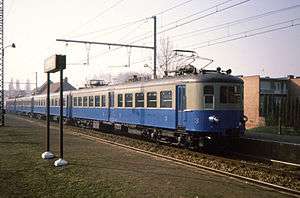SNCB Class AM35
NMBS/SNCB Class AM35 (Automotrice 35 French for Electric Multiple Unit (EMU) – 1935 [after their year of construction]) were electric multiple unit trains operated by the National Railway Company of Belgium (NMBS/SNCB). First used in service on May 5, 1935 (a century to the day after the founding of the Belgian Railways) along the first electric line between Brussels and Antwerp. [2]
| NMBS/SNCB series 35 | |
|---|---|
 Unit 12 on a special fan trip in 1990. | |
| In service | 1935 to ? |
| Manufacturer | first 12 cars Société anonyme la Métallurgique, next 12 cars Ateliers de la Dyle |
| Built at | Société anonyme la Métallurgique: Nivelles, Ateliers de la Dyle: Louvain |
| Constructed | 1935 |
| Refurbished | 1967 |
| Number built | 12 |
| Number preserved | 2 |
| Number scrapped | 10 |
| Fleet numbers | 228.001 to 228.012 - A1 to A12 |
| Capacity | second and third class compartments |
| Operator(s) | NMBS/SNCB |
| Line(s) served | Brussels and Antwerp |
| Specifications | |
| Train length | 91.05 m (298 ft 9 in) |
| Width | 2.97 m (9 ft 9 in) |
| Height | 3.88 m (12 ft 9 in) |
| Doors | 6 per side and per car |
| Maximum speed | 120 km/h (75 mph) |
| Weight | 242 t (533,500 lb) |
| Traction system | Electric - 3000 Volts DC |
| Power output | 968kW |
| Current collection method | overhead pantograph |
| UIC classification | Bo'Bo' + 2'2' + 2'2' + Bo'Bo' [1] |
| Coupling system | Henricot semi automatic coupler |
| Track gauge | 1,435 mm (4 ft 8 1⁄2 in) |
Twelve Electric Multiple Units consisting of four carriages set ran at 120 kilometres per hour between the two cities. [2]
Technical Details
The EMUs consisted of two motorized cars at the ends and infill trailers. Two manufacturers were selected for the power cars: 12 were built by the Société Anonyme la Métallurgique (Nivelles) and fitted with ACEC electrical equipment, the other 12 were assembled by the Ateliers de la Dyle (Leuven) and equipped by SEM (Société d'Électricité et de Mécanique). [3]
The units were delivered in “blue and beige livery, fluid lines and detailed finishing” and proved quite popular with the travelling public. They featured an interior design by Belgian architect and designer Henry Van de Velde, who was then artistic advisor for the Belgian National Railways. [2]
Preservation
One example was kept by the SNCB and was later put on display at Train World [2] and unit 002 is in private hands.
References
- "AM 35". railpasson.org (in French). Retrieved April 19, 2020.
- "Discover Train World in 3D". Train World. 2020. Retrieved April 19, 2020.
- Vandenberghen, J. (1996). Historique de la traction électrique en Belgique. Tome 2 : 1935 - 1939 (in French). Brussels: SNCB éditions. p. 519-548.